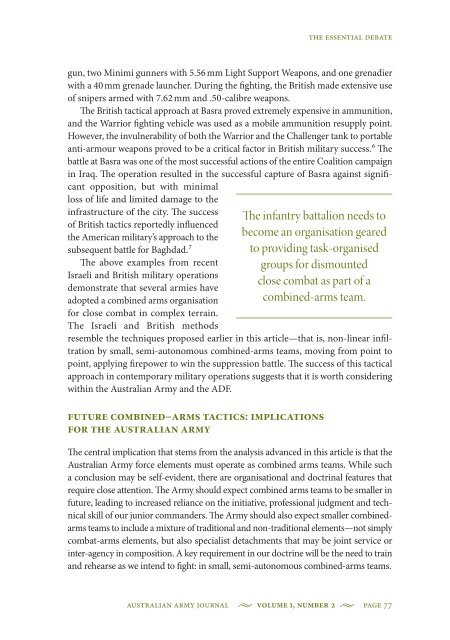The Essential Debate: Combined Arms and the ... - Australian Army
The Essential Debate: Combined Arms and the ... - Australian Army
The Essential Debate: Combined Arms and the ... - Australian Army
Create successful ePaper yourself
Turn your PDF publications into a flip-book with our unique Google optimized e-Paper software.
<strong>The</strong> <strong>Essential</strong> <strong>Debate</strong>gun, two Minimi gunners with 5.56 mm Light Support Weapons, <strong>and</strong> one grenadierwith a 40 mm grenade launcher. During <strong>the</strong> fighting, <strong>the</strong> British made extensive useof snipers armed with 7.62 mm <strong>and</strong> .50-calibre weapons.<strong>The</strong> British tactical approach at Basra proved extremely expensive in ammunition,<strong>and</strong> <strong>the</strong> Warrior fighting vehicle was used as a mobile ammunition resupply point.However, <strong>the</strong> invulnerability of both <strong>the</strong> Warrior <strong>and</strong> <strong>the</strong> Challenger tank to portableanti-armour weapons proved to be a critical factor in British military success. 6 <strong>The</strong>battle at Basra was one of <strong>the</strong> most successful actions of <strong>the</strong> entire Coalition campaignin Iraq. <strong>The</strong> operation resulted in <strong>the</strong> successful capture of Basra against significantopposition, but with minimalloss of life <strong>and</strong> limited damage to <strong>the</strong>infrastructure of <strong>the</strong> city. <strong>The</strong> successof British tactics reportedly influenced<strong>the</strong> American military’s approach to <strong>the</strong>subsequent battle for Baghdad. 7<strong>The</strong> above examples from recentIsraeli <strong>and</strong> British military operationsdemonstrate that several armies haveadopted a combined arms organisationfor close combat in complex terrain.<strong>The</strong> Israeli <strong>and</strong> British methods<strong>The</strong> infantry battalion needs tobecome an organisation gearedto providing task-organisedgroups for dismountedclose combat as part of acombined-arms team.resemble <strong>the</strong> techniques proposed earlier in this article—that is, non-linear infiltrationby small, semi-autonomous combined-arms teams, moving from point topoint, applying firepower to win <strong>the</strong> suppression battle. <strong>The</strong> success of this tacticalapproach in contemporary military operations suggests that it is worth consideringwithin <strong>the</strong> <strong>Australian</strong> <strong>Army</strong> <strong>and</strong> <strong>the</strong> ADF.Future <strong>Combined</strong>–arms Tactics: Implicationsfor <strong>the</strong> <strong>Australian</strong> <strong>Army</strong><strong>The</strong> central implication that stems from <strong>the</strong> analysis advanced in this article is that <strong>the</strong><strong>Australian</strong> <strong>Army</strong> force elements must operate as combined arms teams. While sucha conclusion may be self-evident, <strong>the</strong>re are organisational <strong>and</strong> doctrinal features thatrequire close attention. <strong>The</strong> <strong>Army</strong> should expect combined arms teams to be smaller infuture, leading to increased reliance on <strong>the</strong> initiative, professional judgment <strong>and</strong> technicalskill of our junior comm<strong>and</strong>ers. <strong>The</strong> <strong>Army</strong> should also expect smaller combinedarmsteams to include a mixture of traditional <strong>and</strong> non-traditional elements—not simplycombat-arms elements, but also specialist detachments that may be joint service orinter-agency in composition. A key requirement in our doctrine will be <strong>the</strong> need to train<strong>and</strong> rehearse as we intend to fight: in small, semi-autonomous combined-arms teams.<strong>Australian</strong> <strong>Army</strong> Journal Volume I, Number 2 page 77
















